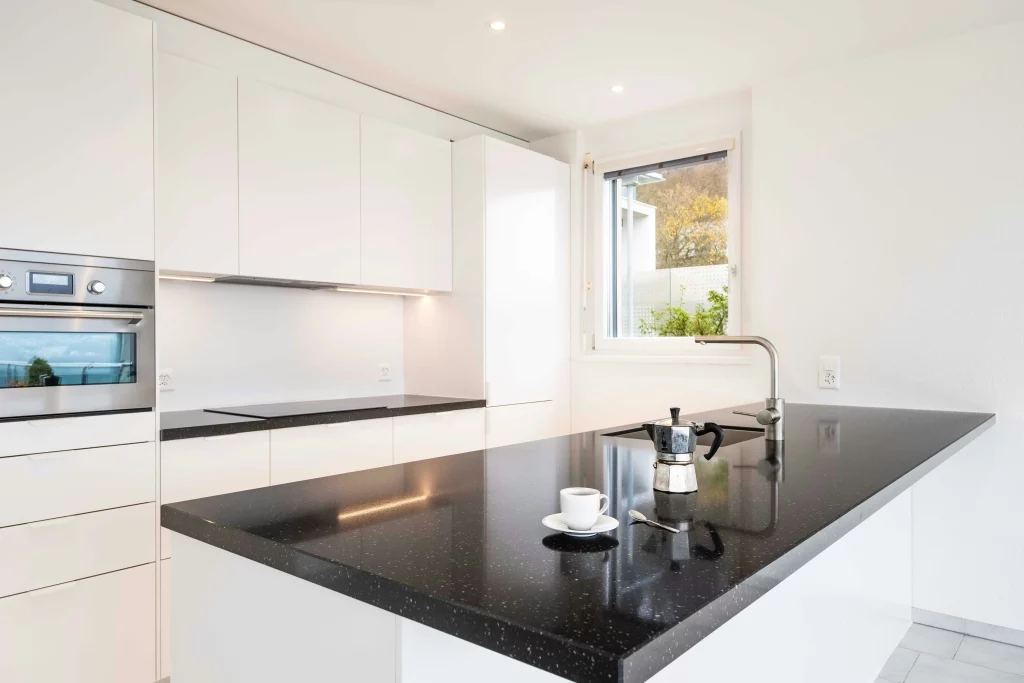Choosing an IKEA kitchen offers several key benefits that make it a popular choice among homeowners. IKEA kitchens are known for their affordability, providing stylish and functional designs at a fraction of the cost of custom kitchen. The modular design allows for high customization, enabling you to create a kitchen that fits your specific needs and space.
IKEA kitchens are DIY-friendly, making them accessible for those who enjoy hands-on projects. The quality of materials, such as MDF and particleboard, ensures durability, and the 25-year warranty on SEKTION cabinets provides peace of mind. With a wide range of styles and finishes, IKEA kitchens offer both versatility and value.
Design and Aesthetics
One of the standout features of IKEA kitchens is their sleek and modern aesthetic. With a wide range of styles and finishes available, there is something to suit everyone’s taste. Whether you prefer minimalist designs that emphasize simplicity or more traditional looks that evoke warmth, IKEA has you covered. h The modular nature of these kitchens allows for extensive customization, enabling homeowners to mix and match components to create a kitchen that perfectly fits their space and lifestyle.
Customization Possibilities
A key advantage of IKEA kitchens is the high level of customization they offer. Homeowners can choose from a variety of cabinet fronts, countertops, and hardware to create a kitchen that reflects their personal style. This modular design means that components can be easily upgraded or changed over time, allowing for continued adaptation as needs evolve. You may know about it here at Kitchen Remodeling.
Functionality and Features
IKEA kitchens are meticulously designed to maximize available space. The systems include various storage solutions, such as pull-out drawers, corner cabinets, and wall-mounted units, ensuring that every inch of the kitchen is utilized effectively. Clever storage ideas, like built-in organizers and adjustable shelves, contribute to a tidy and functional environment, allowing homeowners to easily access kitchen essentials.
Durability and Quality
While IKEA kitchens are typically not made from solid wood, they utilize durable materials like medium-density fiberboard (MDF) and particleboard. These materials are engineered to endure the rigors of daily use, ensuring longevity. Furthermore, IKEA backs its SEKTION kitchen cabinets with a 25-year warranty, offering buyers peace of mind regarding the durability of their investment.
Installation Process
IKEA kitchens are particularly well-suited for DIY enthusiasts. The flat-pack nature of the products simplifies transportation and assembly, making it easier for homeowners to take control of their kitchen projects. Detailed instructions and online resources are readily available, guiding users through the installation process step-by-step. This DIY approach not only fosters a sense of ownership over the kitchen but can also result in significant cost savings.
For those who prefer to leave installation to the professionals, IKEA offers installation services. This option ensures that the kitchen is set up correctly and efficiently, alleviating the stress and time commitment associated with DIY assembly. Utilizing professional installation can also help prevent common issues that may arise from improper setup.
Planning and Consultation Services
IKEA provides free kitchen planning services, both online and in-store, allowing homeowners to design their kitchens with the assistance of knowledgeable specialists. Booking an appointment with a kitchen expert can help ensure that the kitchen meets specific needs and fits perfectly within the designated space. This personalized approach is instrumental in creating a functional and stylish kitchen.
Advantages of IKEA Kitchens
One of the most significant benefits of IKEA kitchens is their affordability. Compared to custom-made kitchens, IKEA offers budget-friendly options that do not compromise on style or functionality. The company’s large-scale production capabilities enable them to maintain competitive pricing across their kitchen products, making stylish kitchen designs accessible to a broader audience.
IKEA kitchens are renowned for their modern designs, offering a variety of styles and finishes to cater to different tastes. The modular nature of these kitchens allows for high levels of customization, making it easier for homeowners to create a space that reflects their preferences and complements their lifestyle.
Flexibility and Adaptability
IKEA kitchens are highly adaptable, allowing for easy changes and upgrades as your needs evolve over time. For those who enjoy DIY projects, assembling and installing an IKEA kitchen can be a fulfilling experience that enhances the personal connection to the space.
Quality and Warranty
While not positioned as luxury options, IKEA kitchens offer good quality for their price point. The materials used, including MDF and particleboard, are designed for durability and long-term use. The 25-year warranty on IKEA kitchen cabinets further strengthens the value proposition for buyers, providing reassurance about the investment.
Convenience in Replacement Parts
IKEA’s commitment to maintaining consistent product lines ensures that replacement parts are readily available. If a component gets damaged, homeowners can easily find matching parts at their local IKEA store, which helps preserve the aesthetic and functionality of the kitchen over time.
Disadvantages of IKEA Kitchens
While IKEA kitchens are designed to be DIY-friendly, assembling and installing them can be time-consuming. Those who lack experience with DIY projects may find the process daunting. Additionally, some users report that the instructions can be complex and challenging to follow, potentially leading to frustration during assembly.
IKEA kitchens primarily utilize MDF and particleboard, which may not be as durable as solid wood options. Over time, these materials can exhibit signs of wear, such as chipping or peeling, especially in high-use areas. Buyers should consider their lifestyle and kitchen usage patterns when evaluating the long-term durability of these materials.
Experiences with IKEA’s customer service can vary significantly. Some customers have reported challenges in obtaining support or replacements, which can be frustrating. The company’s self-service model means that homeowners may need to navigate issues independently, which can be a daunting prospect for some.
Limitations in Customization
While IKEA kitchens offer a good level of customization, they may not provide the same degree of flexibility as fully custom kitchens. The modular components come in standard sizes, which may not perfectly fit all spaces. This limitation could pose challenges for those with uniquely shaped kitchens or specific design visions.
Concerns Over Durability
For households with heavy kitchen usage, IKEA kitchens may not hold up as well as higher-end options. Over time, components such as doors and drawers may become misaligned, impacting the overall appearance and functionality of the kitchen. Buyers should assess their specific needs and usage patterns when considering an IKEA kitchen.
Conclusion
IKEA kitchens present a compelling option for homeowners seeking affordability, modern design, and flexibility. They are particularly well-suited for those on a budget or individuals looking for a DIY project. However, potential drawbacks, such as material quality and challenges with assembly and customer service, should be carefully considered.
Weighing these pros and cons, you can determine whether an IKEA kitchen aligns with your needs and is the right choice for your home. Ultimately, with the right planning and consideration, an IKEA kitchen can become a beautiful and practical centerpiece in your living space, combining style, functionality, and value.







